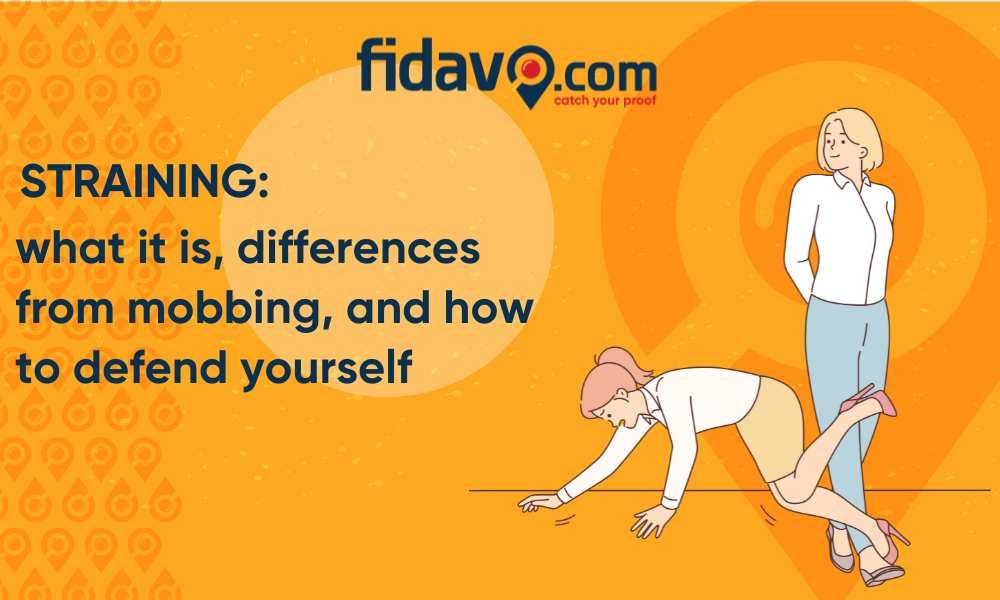Straining: what it is, differences from mobbing, and how to defend yourself

You probably haven't heard the word "straining," but you might recognize behaviors related to it. This term is not commonly used in Italy, where words like "mobbing" and "stalking" have become part of everyday language for at least two decades.
In the following lines, you will discover what it entails, what current regulations dictate, the differences from other types of persecutory acts, and how to defend yourself if you're a victim.
We are talking about a state of tension induced in the workplace: the verb "to strain," in fact, means to force, fatigue, or exert pressure. The victim experiences an action (often concluded in the present but with future effects) capable of causing stress, with long-term repercussions.
This conduct could be attributed to the employer or immediate superiors, so we can assume a hierarchical relationship between the parties involved. Here are the most frequent behaviors:
- Difficulty in accessing or depriving you of the tools necessary for your tasks.
- Unjustified demotion.
- Removal from your usual work environment.
- Thinning out or canceling contact with colleagues.
The change from before to after is always towards an unfavorable condition, with negative consequences for the health, safety, and integration of employees.
What the Law Says
According to Article 2087 of the Civil Code, your employer is required to ensure health, safety, and integration within the company, rights that are violated every time pressure is exerted on employees. All of this is in line with Article 23 of the Constitution, which states that no one can impose financial or personal obligations on others. Article 2103 of the Civil Code is also an important source for regulating forced stress, especially regarding unjustified demotions and changes of department. In this case, the worker must perform the tasks for which they were hired or, in a period subsequent to the contract's signing, tasks corresponding to the same, higher, or lower level. In other words, the legal category must remain the same, and changes to the organizational chart cannot occur for reasons related to antipathy, character incompatibility, favoritism, or personal matters.
Differences Between Straining and Mobbing
At first glance, the two behaviors may seem similar, but there is a substantial difference between them. While serial acts are a requirement for mobbing, they are not even necessary in workplace straining; a single behavior with long-term negative repercussions is enough.
Another distinguishing element is the presence or absence of harassing intent. In mobbing, it is clear (for example, when the employer repeatedly insults you or another employee), while it does not exist in straining.
The absence of a hierarchical relationship between the active and passive subjects also differentiates mobbing from behaviors aimed at causing tension. In the latter case, it is implicit that the improper conduct is carried out by an individual at a higher level than the victim.
How to Recognize Workplace Straining
You can easily identify such behaviors because they have long-term effects. You only need to be a victim once of behavior with these characteristics; you don't have to wait for a similar episode to occur within a limited time frame.
For example, you might suffer from back pain, but they move you to a department where you have to lift heavy objects. In this case, your employer (or the responsible party) is committing this type of offense, so you can report it.
How to Defend Yourself from Straining
The most effective way to protect yourself is to seek the support of a private investigator. You can entrust them with the task of observing the suspected person and collecting evidence of their malice, after reviewing the documentation related to the position and tasks performed before and after the triggering event.
The investigative agency also has all the means to demonstrate the state of inactivity following the episode of forced stress, as well as the discomfort resulting from it. The detective will also conduct specific investigations into which tasks the employer assigned to the victim, searching for both official and actual motivations.
To gather as much information as possible, the investigator may ask you to keep a diary with all the details of your days at work. Along with collecting written documents, photos, audio recordings, messages, and phone calls, they can compile a report on the overall situation, allowing you to initiate a straining proceeding.
If you want to learn more about the topic, we recommend contacting a licensed professional issued by the Prefecture. If you are the owner of a business, you can also take a specialized course to prevent recidivist behaviors.
 EN
EN  IT
IT 